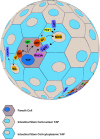Self-organization of organoids from endoderm-derived cells
- PMID: 33221939
- PMCID: PMC8026476
- DOI: 10.1007/s00109-020-02010-w
Self-organization of organoids from endoderm-derived cells
Abstract
Organoids constitute biological systems which are used to model organ development, homeostasis, regeneration, and disease in vitro and hold promise for use in therapy. Reflecting in vivo development, organoids form from tissue cells or pluripotent stem cells. Cues provided from the media and individual cells promote self-organization of these uniform starting cells into a structure, with emergent differentiated cells, morphology, and often functionality that resemble the tissue of origin. Therefore, organoids provide a complement to two-dimensional in vitro culture and in vivo animal models of development, providing the experimental control and flexibility of in vitro methods with the three-dimensional context of in vivo models, with fewer ethical restraints than human or animal work. However, using organoids, we are only just beginning to understand on the cellular level how the external conditions and signaling between individual cells promote the emergence of cells and structures. In this review, we focus specifically on organoids derived from endodermal tissues: the starting conditions of the cells, signaling mechanisms, and external media that allow the emergence of higher order self-organization.
Keywords: Emergence; Intestine; Liver; Lungs; Pancreas; Prostate.
Conflict of interest statement
The authors declare no competing interests of any nature.
Figures



References
-
- Eiraku M, Watanabe K, Matsuo-Takasaki M, Kawada M, Yonemura S, Matsumura M, Wataya T, Nishiyama A, Muguruma K, Sasai Y. Self-organized formation of polarized cortical tissues from ESCs and its active manipulation by extrinsic signals. Cell Stem Cell. 2008;3(5):519–532. - PubMed
-
- Sato T, Vries RG, Snippert HJ, van de Wetering M, Barker N, Stange DE, van Es JH, Abo A, Kujala P, Peters PJ, Clevers H. Single Lgr5 stem cells build crypt-villus structures in vitro without a mesenchymal niche. Nature. 2009;459(7244):262–265. - PubMed
Publication types
MeSH terms
LinkOut - more resources
Full Text Sources
Other Literature Sources

